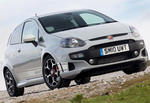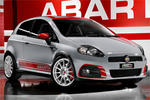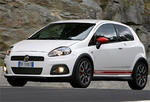
Fiat announced today the return of the Abarth brand in the UK. The Fiat Grande Punto Abarth will be the first model to be launched in the UK with the Fiat 500 Abarth following next year.
The British version of the Fiat Grande Punto Abarth is powered by the 1.4 T-Jet engine developing 155 hp at 5500 rpm and 206 Nm of torque at 3000 rpm (230 Nm at 3000 rpm in Sport Boost mode).
The special edition Fiat Grande Punto Abarth ESSEESSE is also coming in the UK with a 1.4 liter engine developing 180bhp at 5750 rpm and 272 Nm of torque at 2750 rpm.
The Fiat Grande Punto Abarth price for the UK market starts at 13,500 pounds OTR.
Fiat Press Release:
A glorious past, a victorious brand name and a rich heritage in motorsport all combine as Fiat Group Automobiles re-launches the Abarth brand in the UK this month (July).
Synonymous with tough, spirited cars, enthusiastic challenges and a passion for thrills, Abarth is back as a stand-alone brand with a new range of models that will not only appeal to Britain’s


legions of sports car enthusiasts, but will demonstrate once again that Fiat Group Automobiles can successfully oversee and underwrite the production of safe, exciting, high performance cars at affordable prices.
First to get the Abarth treatment is the successful Grande Punto, the popular supermini that is still one of the largest cars in the highly competitive B segment. Grande Punto combines space, accommodation and flexibility with state-of-the-art technology and a rewarding driving experience which lends itself perfectly to Abarth engineering.
But that’s only the start: an Abarth version of Fiat’s new 500 supermini has just been launched in mainland Europe, and is scheduled for a UK introduction early next year. And there are further exciting plans in the pipeline. Abarth’s fast-paced roll-out has initiated an expansion of its production capability in the division’s new home at the Mirafiori plant in Turin, Italy. These new premises group together Abarth’s manufacturing, motorsport, engineering, design and management departments.
Three versions of the Grande Punto Abarth will become available in the UK later this year: the 1.4 T-Jet priced from £13,500 on-the-road, and two further upgrade offers promising even more driver involvement. The first tuning kit, known as Assetto, is designed to enhance the chassis of the car, including the brakes and suspension. The kit includes ventilated and cross-drilled front brake discs, and cross-drilled rear discs, high performance (softer) front brake pads, special shorter (-15/20 mm) springs and 18-inch white painted alloy wheels fitted with 215/40 ZR18 Pirelli P Zero tyres.
The second option – known as the esseesse (SS) kit – primarily increases the power of the engine, and is only available in conjunction with
the Assetto kit. It adds several components including a special air filter, a larger Garrett turbocharger, new injectors, larger diameter freeflow exhaust system, and a revised engine control unit with esseesse software. All of this boosts engine performance from 155 bhp to 180 bhp. Visually, the £3,500 esseesse kit includes unique logos for the tailgate, wing mirror covers and engine cover.
POWER AND ELEGANCE
Compared with the standard Grande Punto, the Abarth’s track has been widened by 6 mm; it is equipped with 17-inch alloy wheels and the option of contrasting striping bearing the Abarth name along each side. The front bumper has been specially redesigned and houses the headlights set in a dark surround, while the larger air intakes, adapted to cater for the turbocharged engine’s cooling requirements, are enhanced with an exclusive Abarth design.
The sideskirts, wheel arch rims and black plastic underbody complete the fairing on the lower section, which is profiled to boost aerodynamic performance and extends as far as the tapered rear bumper. The Abarth badge is clearly visible, positioned in the centre of the front grille, the rear hatch, and on both flanks, at door handle height.
Inside, the Abarth touch is equally apparent. The charismatic Abarth scorpion badge is positioned on the passenger side of the dashboard, for example, while the ‘carbon effect’ central console is decorated with a textured cube motif. The car’s instrument panel has been given a sporty new design, and the same smart finish is used for both the steering wheel and gear stick – black leather with red stitching.
Driver and front passenger seats have also been designed to capture the style and driving experience of Abarth. Both have built-in head restraints, lumbar support and excellent lateral thigh support. On request, the seats and central dashboard section can be finished in full grain leather.
A comprehensive equipment package includes a host of safety and comfort-enhancing features. Safety features include window airbags, side airbags, height adjustable driver's seat, Blue&Me hands-free communications system, foglights, rear head restraints, ABS and ESP. The importance of safety is also shown by the fact that ESP comes as standard and cannot be deactivated. Equipment designed to enhance comfort includes a radio/MP3 player, fully adjustable steering wheel, air conditioning, dark tinted windows, electric front windows, Dualdrive electric power steering and cruise control.
STING IN THE TAIL
The launch of the Grande Punto Abarth is a tribute to an ‘army’ of small Fiats from the 1950s and 1960s, that were given a tough, dynamic and sporty edge by the ‘magic hands’ at Abarth. They were ‘scorpions’ with a real sting in the tail, igniting the passion of thousands of drivers with a taste for challenge, speed, and Italian flair. Today, the Grande Punto Abarth is the first of a series of road and competition cars aiming to bring back those former glory days of excitement, success and high performance.
The Grande Punto Abarth is fitted with a 1.4 turbo (T-Jet) petrol engine, delivering 155 bhp. Combining with a 6-speed manual gearbox, the engine gives the car a top speed of 129 mph, and a 0-62 mph acceleration time of just 8.2 seconds. The Grande Punto Abarth is not just a high performing small car – it is also safe, and respectful of the environment. Safe because the tuning is not limited to the engine and the aerodynamics: the car’s brakes and chassis set-up have also been upgraded and professionally engineered to cope with the improved performance.
Developed to combine the sporting performance and low NVH characteristics of a high-tech petrol engine with fuel economy comparable to a diesel unit, and CO2 emission levels which readily comply with increasingly stringent European regulation, the 1.4 litre T-Jet engine in the Grande Punto Abarth is already a well proven, durable and responsive engine.
Through cubic capacity downsizing allied to the adoption of a small turbocharger, this remarkably responsive 155 bhp 1.4 litre T-Jet engine delivers a performance equal to or better than a conventionally aspirated 2.0 litre engine with a reduction of between 10% and 20% in fuel consumption and emissions.
Employing state-of-the-art computer aided design and calculation systems to simulate unit stress under turbocharging, every aspect of this latest 1.4 litre powerplant has been re-evaluated. Three-dimensional computational fluid-dynamics studies of the entire thermodynamic cycle, injection phase and the engine cooling circuit, as well as thermo-mechanical analysis of cylinder head, block and piston stress, resulted in comprehensive redevelopment of the combustion system, intake and exhaust manifolds, camshaft profiles and phasing, intake system, engine coolant circulation and spark plugs.
Compared to the superseded 1.4 FIRE engine from where it traces its lineage, the Grande Punto Abarth’s 1.4 T-Jet engine features optimised intake port and manifold design; a revised injection system and a bespoke spark plug design to improve knock resistance and pre-ignition; a reduction in both inlet and exhaust valve lift time to optimise air mass flow; a reduction in compression ratio from 11:1 to 9.8:1; piston, connecting rod and crankshaft redesign; a new, reduced volume exhaust manifold for maximum exploitation of the exhaust pulse energy, and improved engine cooling efficiency through a revised coolant path and a redesigned water pump impeller.
Excellent combustion characteristics have allowed for the adoption of a notably small turbocharger. With a turbine diameter of only 33 mm, this highly compact and responsive unit is located directly above the exhaust manifold, with the attendant catalytic converter close-coupled to the turbine exit.
Via a ‘drive-by-wire’ throttle system, the 1.4 litre T-Jet engine provides outstanding low-end torque, almost entirely devoid of the lag in power delivery traditionally associated with turbocharger installations.
Via a Sport Boost button located in the centre console of the Grande Punto Abarth, the engine will deliver an impressive 169 lb ft of torque at 3000 rpm, (152lb ft in normal mode), endowing the vehicle with a 0-62 mph acceleration time of 8.2 seconds and a top speed of 129 mph. Notwithstanding such strong performance, this superbly responsive powerplant will nevertheless return over 40 mpg in the combined cycle and restrict CO2 emissions to just 162 g/km.
Additionally use of the Sport Boost function modifies the amount of steering effort required by the driver, so as to give a sportier feel.
Grande Punto Abarth is eco-friendly because, despite having far more horsepower than the model on which it is based, it complies with the same legislation on noise and emissions (Euro 4 approved engine). Developed by Abarth’s team of specialist designers and engineers, along with the technicians who produced the Fiat Grande Punto (one of Europe’s most successful cars), the Grande Punto Abarth is factory-built, and is subject to all the regulations and rigorous checks applied to standard models.
For top stopping power the car is equipped with disc brakes all round; the front brakes being ventilated and equipped with powerful Brembo fixed four-piston callipers.
The Grande Punto Abarth’s suspension is based on the tried and tested set-up of the Fiat Grande Punto, which means MacPherson struts and anti-roll bar at the front and torsion beam suspension at the rear, but it is significantly modified. The anti-roll bar has been thickened (diameter 19 mm), the front springs are 20 per cent stiffer, and the ride height is lowered by 10 mm. With this combination in place, the car provides impeccable road holding and enhanced driver involvement while maintaining a high standard of comfort.
ASSETTO AND ESSEESSE KITS
The Assettoand esseesse kits, which are delivered to customers packed in original wooden crates – in keeping with Abarth tradition – may only be sold and installed by the official network of Abarth Assetto Corse tuners on a Grande Punto Abarth 1.4 Turbo T-Jet 155 bhp. This conversion must take place within one year or 20,000 km (12,000 miles) from its first registration. Conversions are covered by a two-year Abarth warranty from the installation date.
Fitted with the full esseesse kit, the Grande Punto Abarth has more than twice the power of the basic Fiat Grande Punto model (a statistic repeated throughout Abarth’s history: the Fiat 500 from 1958 had 13 bhp, while the Abarth-modified car boasted 26). With the full Abarth treatment and fitted with a 1.4-litre 16v turbo engine enhanced to 180 bhp (at 5750 rpm) and with a maximum torque of 272 Nm at 2750 rpm, (200 lb ft), the Grande Punto Abarth esseesse can achieve a maximum speed of 133 mph, accelerating from 0-62 mph in just 7.5 seconds. The modifications to the brakes and suspension contained within the kit mean the Grande Punto Abarth is more than capable of transmitting all this power to the road in a usable, safe and enjoyable manner.
The finishing touches to the kit include 18-inch alloy wheels and various mechanical modifications to alter the car’s dynamics, for example: the special set-up (both the front and rear suspension are lowered by a further 20 mm compared with the standard Grande Punto Abarth), and the enhanced braking system (the front discs are cross-drilled and fitted with softer, high-performance pads).
An integrated product, the esseesse kit is also safe, since the engine cannot be tuned unless the brakes are enhanced and the set-up is modified at the same time. All this will only be possible at Abarth tuning centres.
As a first step up from the standard Grande Punto Abarth, a handling (Assetto) kit is offered, which includes springs that lower the ride height by 15-20mm, special front brake pads, cross-drilled front disc brakes and alloy wheels with very low profile tyres. The full kit, comprising engine and chassis modifications (esseesse) includes: Garrett GT 1446 turbocharger which increases boost pressure from 1.3 to 1.5 bar, new water and oil pipes to the turbo, new exhaust manifold, heat shield, complete injector rail, MAP sensor, boost sensor, modified catalytic converter, larger diameter exhaust, new intercooler pipework, adapted radiator pipe, new water pump, wastegate valve, and new engine ECU.
SUPER SUPERMINI
The second car to receive Abarth’s exceptional engineering work is the iconic 500, which set the motoring world alight following its launch in July 2007. Faithful to the ‘small but wicked’ phrase coined for Abarth cars in the 1950s, the new 500 Abarth, which is making its mainland Europe debut this summer, is a small car with stunning performance. Powered by a similar 1.4-litre 16-valve Turbo petrol engine, it delivers a maximum 135 bhp at 5500 rpm and peak torque of 206 Nm (152 lb ft) at 3000 rpm in ‘Sport’ mode. In ‘Normal’ mode the maximum torque becomes 180 Nm (132 lb ft) at 2500 rpm.
The new 500 Abarth is rapid but also environmentally aware: just like the regular Fiat 500, it is built to Euro 5 standards well in advance of forthcoming legislation. The Abarth version also features the new TTC (Torque Transfer Control) feature which improves the transfer of drive torque to the wheels but, above all, ensures that the car behaves impeccably while cornering, making it even safer and more entertaining to drive when travelling at speed.
Like its Grande Punto stablemate, the 500 Abarth is no mere styling exercise. The assertive yet practical design is driven by the need to improve the 500 Abarth’s performance. Perhaps the best demonstration of this set-up is the particular care and attention that went into the aerodynamics and functionality of certain elements of the car. Compared with the basic car’s body, for example, the 500 Abarth has improved dynamic performance thanks to the extension of the roof with a large fin spoiler, and a ‘slide’ from the underbody to the air intakes, taking in a large section of the rear bumper. Two tailpipes are fitted on either side of this ‘slide’, placed symmetrically at the outlets to a single silencer positioned transversely. (They also have the Scorpion logo, just like they did in the 1960s.)
The front of the car also clearly demonstrates the 500 Abarth’s sporting credentials. There’s a triple air intake – the central one being larger than on the series model – and a much broader opening above the number plate. Additionally, two symmetrical ‘nostrils’ on each side of the bumper correspond exactly to the position of the two identical intercoolers, which can be seen through these apertures, guaranteeing optimum intake and airflow.
The nose, with its Abarth logo, has also been extended forwards to make space for the turbocharger, which gives the 500 Abarth a more pronounced, dramatic side profile, in keeping with the best Abarth tradition. On the old 850 TC and 1000 TC models, the external elements that made them so collectable were highly visible and recognisable as characteristics of the brand.
As with Grande Punto Abarth, the Abarth coat of arms appears on the flanks, pierced by a tricolour lightning bolt, just like on the Abarth 595 and 695 from the 1960s, symbolising the brand’s racing heritage. Sideskirts envelop the curves of the car, creating a more vertical profile and improving the Cd. Lastly, the 16-inch or 17-inch wheels come in a variety of different styles, including a multi-spoke and a holed version (a clear reference to certain stylistic features of forged wheels in the 1970s).
Inside, the 500 Abarth has a decidedly sporting feel, with special instrumentation and an analogue turbo pressure gauge. The main instrument panel has sporty graphics and includes a boost gauge/gearshift indicator, while the three-spoke steering wheel features special thumb-grips and is ‘flat’ at the base to make it easier to adjust. The distinctly ‘racing’ feel is also in evidence in the pedals, which are aluminium with rubber inserts, in the gear lever knob (upholstered in leather with a sporty, more ergonomic grip) and in the ‘unified’ seats with head restraints built into the seat backs. Lastly, the roof lining and side trims are black, giving the cabin an appropriately sporty look.
NEW ABARTH HQ
Abarth opened its purpose-built new premises in February this year at the Fiat Group’s Mirafiori complex in Turin.
The motorsport, design and manufacturing divisions, along with the revered Abarth Racing Team, are housed in the 23,000m2 building, which took a mere eight months to construct. It houses more than 100 employees.
Located in the former Mirafiori engineering plant – known as Officine 83 – the Abarth building is perfectly placed to interact directly with the Fiat Group’s Style Centre (Centro Stile), experimental construction centre and the Engineering and Design departments.
Inside, the new HQ has been divided into several different areas: competition cars, prototype development, cars derived from standard production, and the Racing Department. Technical and design offices are located right next to the workshops, while marketing, sales, finance and other units are housed on the floor above. The new workshop, which is equipped with eight vehicle lifts, features an area set aside as a future assembly line for specialist Abarth cars in small production runs.
The building’s entrance hall houses the company’s characteristic ‘Wall of Fame’ showing famous Abarth victories, while next to the entrance is a 560m2 showroom displaying models and artefacts from Abarth’s rich history.
HISTORY AND HERITAGE
Founded in 1949 by the Austrian Carlo Abarth, the company made its début in the racing world with the 204 A Roadster (based on the Fiat 1100), which became instantly capable of winning the Italian 1100 sport and Formula 2 championships.
The brand became increasingly popular among motoring enthusiasts and its progress appeared unstoppable. Over the years it became a particularly authoritative name, reaching its peak at the end of the 1950s and throughout the 1960s. Carlo Abarth devoted himself entirely to building up the ‘Scorpion’ legend, and his work rate, almost frenetic, revealed the nature of his genius.
This epic success story, almost without equal, forged ahead at a pace that is incredible even by today's standards. A long road, marked by records, victories and ground-breaking ideas that were to change the way people looked at sports cars.
In 1956, using a Fiat Abarth 750 styled by Bertone, Abarth set a lengthy string of endurance and speed records: at the Monza circuit on 18 June, he beat the 24 hour record, covering 3743 km at an average speed of 155 km/h. Later, from 27-29 June, on the same circuit in Lombardy, he notched up a series of records: the 5000 and 10,000 km, the 5000 mile, and even the 48 and 72 hour records. His success was international, and the influential German magazine Das Auto Motor Und Sport, in its issue no. 15 (21 July 1956), even featured the Abarth 750 on its cover. The same car was styled by Zagato in two different versions: the Fiat Abarth 750 Zagato (1956)
and the Fiat Abarth 750 GT Zagato (1956). On 11/12 May 1957, at the 24th Mille Miglia, there were no fewer than 20 ‘Scorpions’ in the 750 class, of which 16 finished the race.
In 1958, Abarth achieved nothing short of a masterpiece with the new Fiat 500, completely transforming the little utility car and enhancing its potential to the full. In the same year, he formed an even closer relationship with Fiat, which agreed to award cash prizes to Abarth according to the number of victories and records set by the team. This event was to form the foundations for the impressive roll of honour that followed: 10 world records, 133 international records and over 10,000 track victories.
The Abarth legend kept on growing, and even became part of everyday parlance. The 1960s were the golden age for Abarth, and the name came to symbolise speed, courage, performance and modification. The list of vehicles which have helped to engrave the Abarth name deep into motor racing history is a long one, from the 850 TC which won at every international circuit including the Nurburgring, to the Fiat Abarth 1000 Berlina and the 2300 S which notched up an extraordinary series of records at Monza, despite adverse weather conditions.
In 1965, Carlo Abarth wanted to set his own personal record. On 20 October 1965, at Monza, with the Fiat Abarth ‘1000 Single-seater Record’ Class G, (105 hp) he set the record for acceleration over the 1/4 mile and 500 metres. The following day, in a 2000 cc class E single-seater, he set the same records for higher categories. Once again, an anecdote says much about the tenacity of this man, who had to lose 30 kilos before he could fit into the narrow cockpit and take his car to victory - at the age of 57.
From 1971 onwards, Fiat Auto became the outright owner of Abarth, and the last vehicle in which its founder was to play an active part was the A112 Abarth. During the 1980s, the story continued with celebrated cars like the Ritmo Abarth and the Fiat 131 Abarth which won the World Rally Championship no fewer than three times: in 1977 and 1978 with Markku Alen (the father of Anton Alen, currently a driver in the Abarth team) and in 1980 with Walter Röhrl.
Abarth has now inherited the activities of the Fiat Racing Team, and has once again entered the world of rallying on a winning streak. Last year, the Grande Punto S2000 won all the championships it entered: the International, European and Italian Rally Challenges.
ABARTH DRIVING SCHOOL – SANDRO MUNARI
Part of Abarth’s philosophy is to build sporting, reliable cars, but always with safety as a top priority. One outcome of this principle is the new Abarth Driving School – Sandro Munari.
The school, created in conjunction with the most famous Italian rally driver, offers young people the possibility of learning the best techniques for combining safety with driving satisfaction, every day.
The Abarth Driving School – Sandro Munari makes available the know-how and experience of a great driver, in conjunction with the latest technology applied to safe and high-performing vehicles, such as Abarth branded cars. The school offers a series of courses, according to the needs and experience of participants, divided into hours of theory lessons followed by hours of practice, with final tests that prove what the students have learned.
Part of the wider campaign to relaunch the Abarth brand, this initiative sets out to emphasise the importance of proper knowledge of driving techniques, that allow greater road safety when combined with a car offering serious performance engineering. This is because Abarth does not just produce lively cars, but considers it essential to raise public awareness of the importance of safety, accident-prevention and road safety education. The intention is to introduce the driving schools across Europe as well as in Italy.
















